Everything you need to know about rats
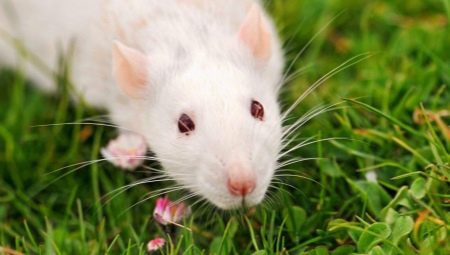
These interesting and intelligent animals are often underestimated, disliked, and less likely to be kept at home as pets than other pets. But one has only to learn more about decorative domestic rats, and the opinion changes completely.

Description
Ornamental house rats are a domesticated form and subspecies of gray rats of the mouse family. The presence of this animal in the life of people has been observed since ancient times. Nowadays, there are many new varieties of rats that have been bred. At first, they were used only as experimental laboratory animals. But in modern times they began to be bred as animals - "companions".
Different types of decorative rats have different sizes, differ in properties and color of wool, body structure and behavior. Their peculiarity is that when even the slightest danger arises, they secrete a specific liquid that smells unpleasant and thereby scare off enemies.
On the body of the animal there is thick and rather dense hair.
Its color is varied: from a dark or light gray shade to black or orange-red with a yellow tint.
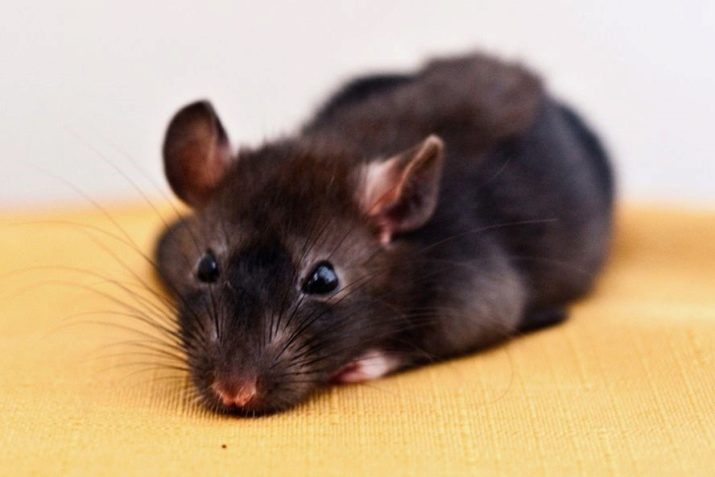
The elongated rat muzzle has a sharp shape, small rounded ears and small oblong eyes, which can have different colors: red, black or ruby, as well as different colors - one black, and the other ruby or red. Animals with red and ruby eyes see slightly worse than rats with black eyes.
Their jaws also have features: the molars of the upper and lower teeth are closely adjacent to each other, forming dense rows.Such a structure allows the rat to chew food quickly and vigorously.
The rootless incisors are much longer than the rest of the teeth. They grow constantly and intensively, so the rat grinds them down regularly so that you can close your mouth. There is an area without teeth between the incisors.
All her teeth are distinguished by their extraordinary strength and sharpness, rats bite painfully and can easily gnaw through any hard surface (brick, hard metal, concrete).
Their tail is very long: its length is either equal to or much longer than the body length, with the exception of the species of short-tailed rats. In almost all varieties, it does not have a coat, but with single bristles and is covered with characteristic scales.
Only the black rat has thick hair on its tail.

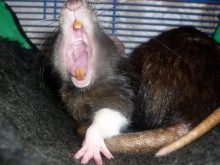
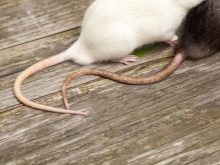
In nature, the rat lives either in a large community, or forming a family clan, or in isolation alone. For dwellings, they choose minks left by other animals, abandoned bird nests, natural shelters or various structures where they rest and sleep.
Rats have a highly developed sense of smell and hearing, which compensate for insufficiently good vision. They do not live long: in the wild up to about 1.5 years. Their lifespan often depends on the type of rat. Decorative house rats live a little longer - up to about 2 years, and with good care they can live for about 4 years.

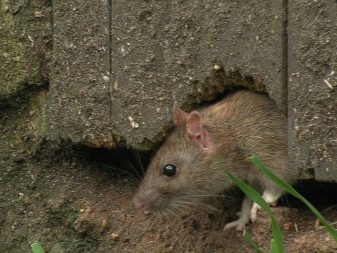
Domestic rats, along with common features with wild species, have differences. First of all, they differ in disposition: they have less aggressive, calmer behavior. Pets calmly react to bright light. Unlike the wild, the domestic rat does not have a pronounced tendency to a nocturnal lifestyle, and in conflicts with other animals, they make sounds, but not so sharp.
The domestic decorative rat quickly gets used to its owner, it is very smart and easy to learn.
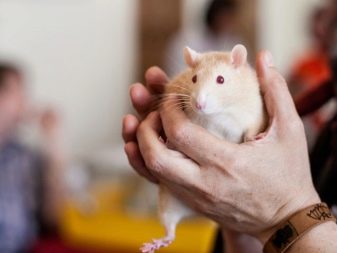
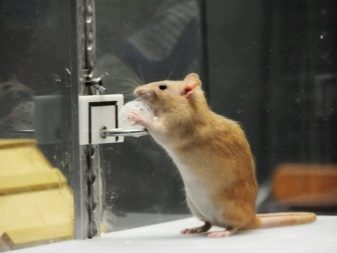
Views
The species diversity of these rodents has more than a dozen, which reflect the characteristic features of the color and quality of wool, body structure and eye color. The most common are these types of rats.
Gray Rat, or Pasyuk
This rat can be found everywhere, on all continents and in all countries, including Russia. The only place they don't live is in the regions beyond the Arctic Circle. Gray rats like to settle in rural areas, in places where farm animals are kept. Their food is the feed of domestic animals and birds.
In conditions of living in the wild, they settle near a water source, and feed on bird eggs or chicks, field mice or carrion. In cities, they settle in garbage bins, basements, various utility and utility rooms. Therefore, they are often called barn rats.
The dimensions of these rats are quite large: they grow up to about 25 cm in length, the tail - up to 20 cm, and the weight can range from 150 to 400 g. The muzzle of the hunter is not pointed, but blunt and wider. Compared to other species, the gray rat's coat is more rigid. The color of the coat depends on the conditions and habitats and varies from shades of gray to red. The coat also changes color as the animal ages.
In young rodents, it is usually light gray, and in older rodents it acquires a reddish tint.
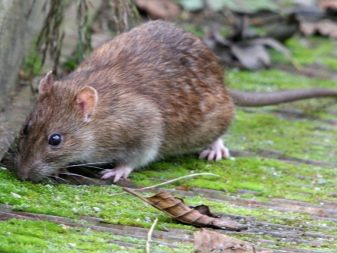
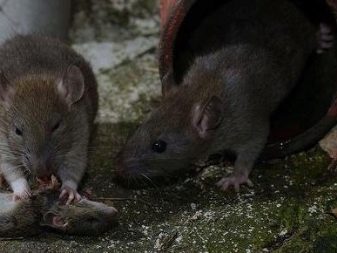
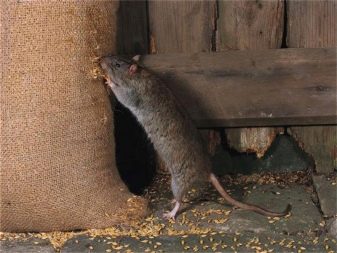

Rat black
This type of rat can be found in European and Asian countries, America, Australia and Africa. The favorite places of settlements of these rats are the cities where they inhabit the last floors of high-rise buildings. In rural areas, they often live in the attics of farms, for which they are nicknamed roofing.
In the wild, they live in forests and green plantings. Grass and branches are used to build nests. They are fed with nuts, grains and sunflower seeds. Can be consumed in food and animals.
The color of their coat also has some shades: black can turn into light brown. The belly is gray or ashy.Thick hair is present on the tail. The dimensions of this rat are somewhat smaller than that of the gray: in an adult rodent, the body is 16 to 22 cm long, weight is from 130 to 300 g. The muzzle with large rounded ears has a narrower shape.
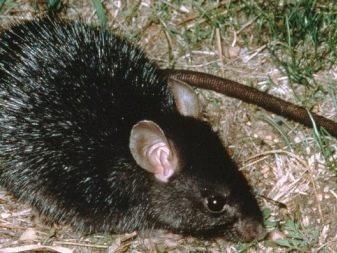
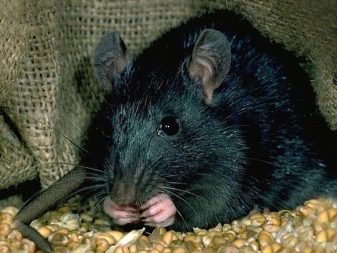
There are also these types of wild rats:
- Turkestaninhabiting Asia (in the cities of India, Tashkent and Samarkand);
- black-tailed, having a tail with thick dark hair;
- small rats (Pacific or Polynesian rodent) - the smallest of all species, having a length of 11 to 15 cm and a weight of 40 to 80 g.



In addition, there are decorative rats that can be kept at home. Decorative rat breeds are also plentiful. The most popular indoor species.
Standard. This type of domestic animal is the progenitor of many other decorative breeds. The rat has a strong, oblong body, smooth and glossy short hair, wide ears and a tail with sparse bristles. Males are somewhat larger than females, but more passive.
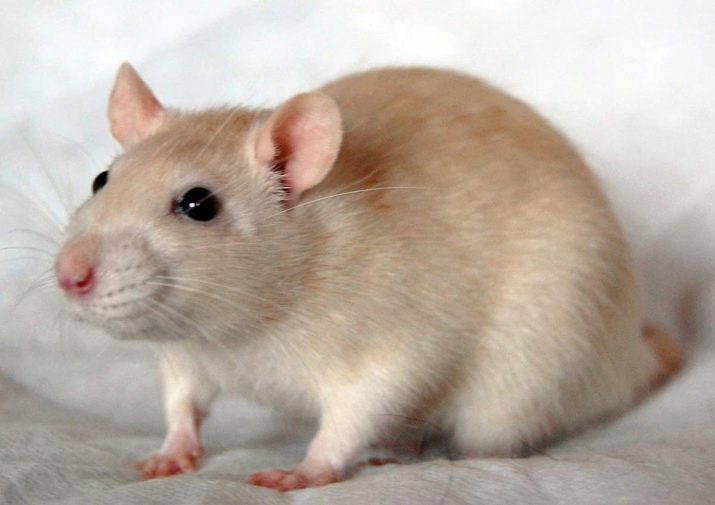
Sphinx. A characteristic feature of this breed is the absence of hair on the body. Separate bristles can be seen only on the head, on the legs and in the abdomen. Rodents have pink and wrinkled skin.

Tailless. Its distinctive feature is the absence of a tail. On the trunk, which has the shape of a pear, wool can grow both in the standard species and curly. Coat colors can be different. The whiskers of curly rats are not very long and curled. These animals are distinguished by very high activity, lively mind and sociability.

Dumbo. This pretty animal has a short, pear-shaped body with a long tail. On a blunt muzzle with a protruding back of the head, rounded and protruding ears are set low, which makes its appearance cute and funny.
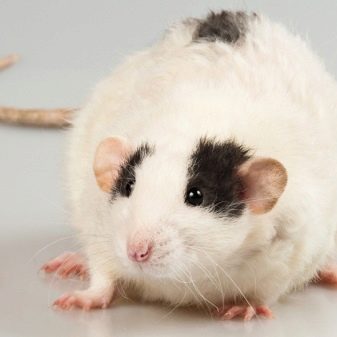

- Satin... This type of rat is very popular in the countries of the European continent. They have a long and dense coat, shiny like satin.
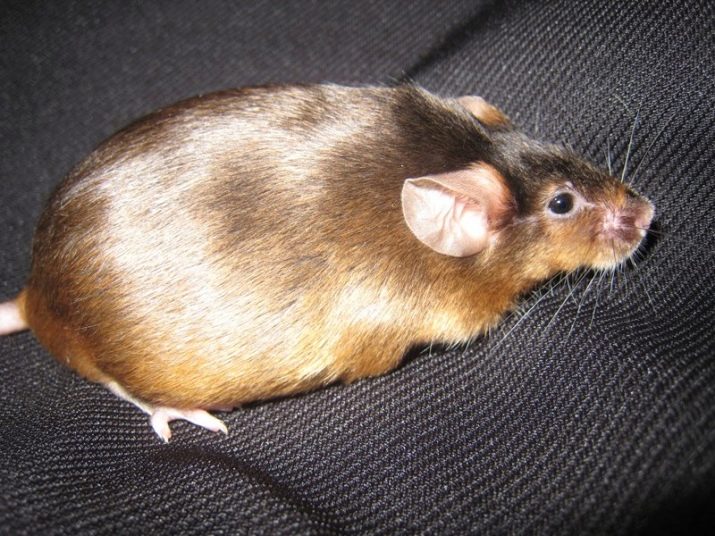
In addition to those listed, there are other breeds of domestic rats:
- rex - this rather large rat stands out among other species with its long thick and curly hair, the animal looks like a soft plush toy;
- white - a beast with an ideal pure white coat color;
- blue - a beautiful rat with blue hair.
A tame rat of any domestic breed is an intelligent, very sociable and attached pet to the owner. The reviews of the owners characterize them even as a person with their own character, who knows their name and responds to it.

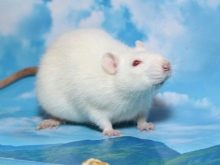

How to determine the sex and age of a rat?
Often, the sex of the future pet is not very important for the owners. But sometimes preference is given to the male or female, or there is a desire to breed. Then you need to recognize the sex of the pet. The reproductive organs are fully formed by 1.5 months of age in rat pups. And only then comes puberty and the rat becomes able to bear offspring.
To distinguish a male from a female and choose the right rodent, you need to know the main sex differences in rats, which are as follows.
- The male has large and easily identifiable testicles (testes). This is his main primary sexual characteristic and difference from the female. The testicles are also palpable. When examining the animal, it is not necessary to raise its tail, since in this position the testicles can sink deep into the abdomen and they may not be detected.
- The female has mammary glands located in two rows on the abdomen and having small nipples. Males do not have such a trait.
- Another sign by which you can recognize the sex of a rat is the different gap between the rectal (anal) and urethra. In females, this gap is much smaller and ranges from 2 to 3 mm, while in boys it is approximately 5-6 mm.
- When examining, it is important to give the pet the correct position: put it with its back on your palm, holding the animal by its head. The tail should be lowered.In no case should you hold it by the tail as in such a position the rat will feel uncomfortable and anxious.
- Also, gender is determined by secondary characteristics - the color of the tail. The young male rat has a deep pink tail, while the female has a white tint. With age (by about 6 months), the male's tail becomes either dark orange or dark pink. And in a female at 7-8 months of age, the tail acquires transverse brown stripes.
In addition, females are smaller in size, they do not have such a muscular and strong physique compared to males. The coat of males is somewhat coarser than that of females.

As for the age, it is almost impossible to know it exactly. The approximate (but not exact) age can be determined only in young rat pups up to one year of age. In older rats, the exact age cannot be determined. Only a very dark orange or red color of the teeth indicates that the animal is over a year old.
The age of young rodents is determined by these characteristics.
- The eyes of young rat pups are completely black and the iris is not detected. Then the iris gradually becomes lighter and only at the age of 5 to 8 months forms a white rim.
- Age is determined by the size of the fifth toe on the forelimbs. Up to 3-3.5 months, they are very small (or completely absent). Upon reaching this age, the first molt occurs, after which the fingers become larger.
- Transverse brown stripes on the tail appear in females around 7-9 months of age, and in boys by 6 months, the tail becomes orange.
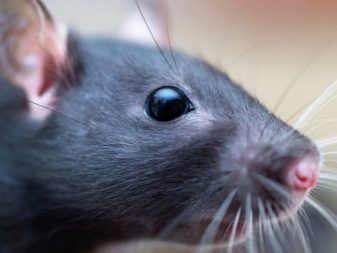

Care
Taking care of a decorative rodent is not difficult at all, you just need to monitor the pet's health, keep its cage clean, and feed it regularly and fully. When leaving, you need to adhere to these rules.
- It is necessary to place a cage with a rodent in dry and warm rooms, inaccessible to drafts. It should not be exposed to direct sunlight.
- Every day you need to clean the cage: throw away the remaining food, remove contaminated areas of the filler and add fresh ones, wash the feeder and drinker, filling them with fresh food and water.
- Twice every 7 days, it is required to process the cage and pallet using special disinfectants.
- If necessary, bathe your pet only in warm, but not hot water, using special shampoos for rodents.
Domestic rats need to periodically trim their nails using a pair of nail clippers or nail clippers.

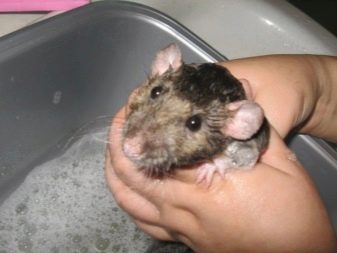
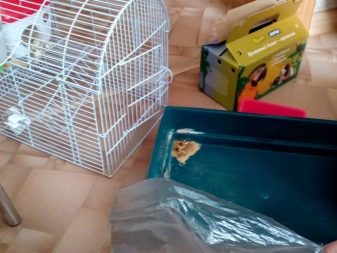
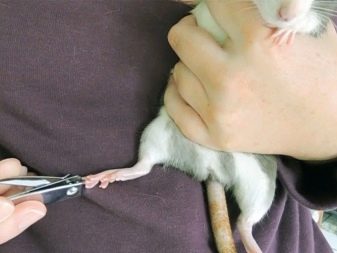
What do rodents eat?
Rats are able to eat food of both plant and animal origin: they are omnivorous. Their optimal diet includes cereals, various grains, seeds and nuts, fresh fruits and vegetables in small quantities. The daily feed rate of the rat is approximately 20-30 g, it must be given 2 times a day, dividing the rate in half.
Hunger is extremely difficult for rats: without food, rodents can die after 3 days. The daily intake of water is about 25-30 ml, and thirst is worse tolerated by them than hunger.
Usually pets are not picky about food, but everyone can have their favorite treat. The diet of domestic rats should be balanced to avoid obesity and digestive diseases.
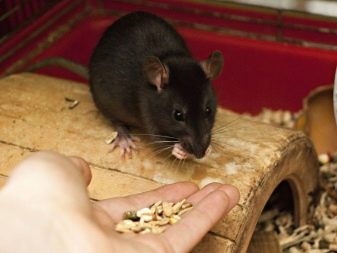
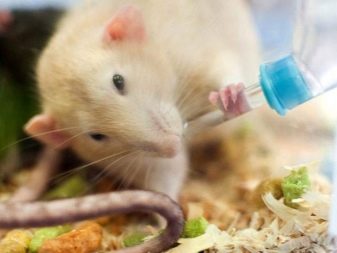
The pet's daily diet includes the following foods:
- various cereals in dry chopped form;
- various cereals - buckwheat and rice, corn and barley, wheat - this is the main component of the rat's diet;
- nuts, flaxseeds, sunflower and pumpkin seeds;
- greens for replenishing the diet with vitamins: in summer dandelion, clover and lettuce leaves, dill, and in winter - sprouted cereals - oats, millet, wheat;
- fermented milk products - cottage cheese and yogurt, fermented baked milk and kefir, which are a source of calcium and improve the intestinal microflora of the rodent;
- boiled eggs and meat products as a source of protein - chicken meat, heart, kidneys and liver, as well as fish;
- dry and fresh fruits and vegetables, berries, which are vitamin supplements to feed and a source of fiber that improves bowel function.



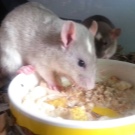
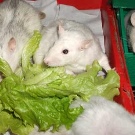

You cannot treat rats with chocolate and alcohol, kebabs and other spicy or fried meats, sweets, raw cabbage and potatoes, spinach and green bananas. Cheese is also bad for rats, despite the fact that they love it very much.
You can pamper your pet with a slice of watermelon, apple and carrot, grapes and strawberries, popcorn and rice, tomato juice is also useful for them.
You can feed the domestic rat with special ready-made dry foods, which include, in addition to grain, pieces of dry vegetables and vitamin granules.
Dry food must be supplemented with fresh vegetables (carrots, zucchini, eggplants) and fruits (apples, plums, ripe bananas).
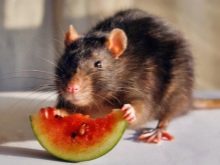


Breeding features
Rats are extremely fertile animals. A female in one litter can have 14 or more cubs. The female is able to become pregnant again even while feeding her rats with milk.
Sexual maturity in males can begin as early as 6 weeks of age, and the female is ready to conceive even earlier. However, the first mating of a female is recommended when she reaches one year of age. Experienced breeders, breeding rats at home, receive from each female 1-2 litters per year, but no more.
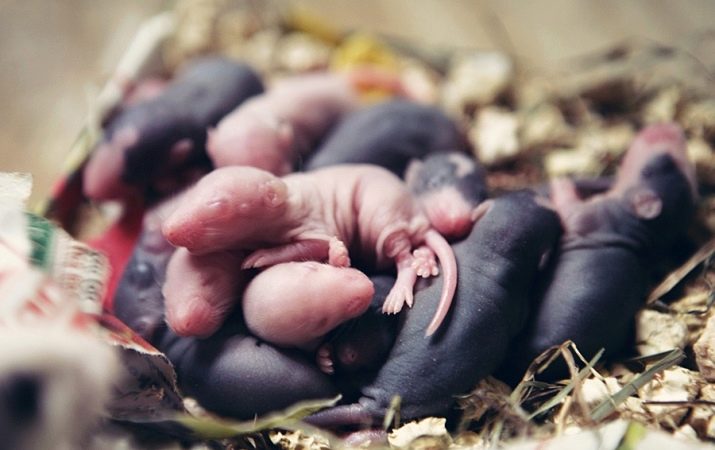
Pregnancy in a rat lasts from 21 to 24 days. A mature female starts flowing every 5 days, and this happens all year round. When the female reaches 1.5 years of age, she begins menopause: the regularity of the cycle becomes unstable, and then it completely stops.
A feature of rat reproduction is that they do not have a specific time for mating: they are able to always have sexual intercourse. But the greatest activity occurs in the spring and summer period.
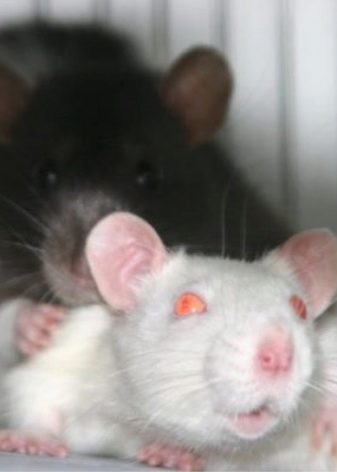
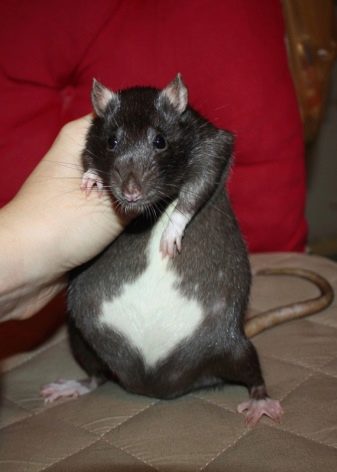
Behavior and training
Rats are representatives of social animals. In their community, there are often fights between adult males for hierarchical status until a leader is determined. But they are mostly tolerant of young offspring, not seeing them as rivals.
Rats have their own way of communicating through gestures, sounds or smells. This language allows them to express pleasure or displeasure, anxiety and fear, threat and love, desire.
When breeding domestic rats, preference was given to non-aggressive, calm specimens during selection. Therefore, decorative pets have a peaceful and good-natured disposition. However, they are also able to bite the offender: this is how they show their dissatisfaction with something.

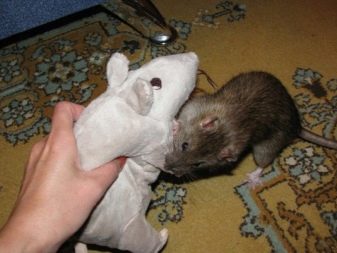
Rats also express their displeasure by hissing and snorting. In an aggressive rat, the fur stands on end, it bares its teeth and squeaks them, presses its ears and strains its body. She can show aggression not only towards her relatives, but also towards humans and other animals. Sometimes aggression is triggered by fear or stress.
Domestic rats also have fights, and they are very fierce. They usually occur before 5-9 months of age, when the process of puberty in males ends.
Although the domestic rat is a rodent, its behavior is very different from that of guinea pigs, mice and hamsters. She looks more like monkeys in her mind and emotional manifestations.
She needs communication with a person, and she prefers it to communication with relatives.
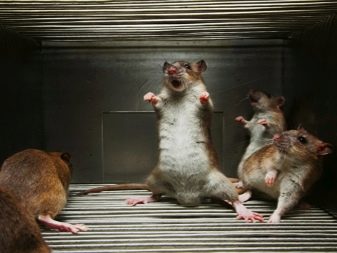
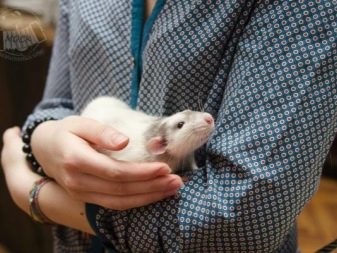
These pets are able to assimilate the meaning of many words, remember their name and owner, the nicknames of other animals. They understand the words "give up", "no", "walk", easily and quickly get used to the daily routine of the owners.
In addition, they are very susceptible and get agitated when they are yelled at or hurt. You can punish a rat for a crime by blowing on the muzzle or turning it over on its back.
Rats love to play and happily chase paper on a thread, like to study unfamiliar objects (boxes, paper, rags). Each pet has its own characteristics of behavior and temperament.


Rats of the satin breed are distinguished by their mobility and activity, quick adaptation to their surroundings and sociability. Such a rat is very curious, but cunning. He prefers to live in a flock, so it is recommended to keep several individuals.
A distinctive feature of the standard rat is its good-natured nature, inability to bite. She allows herself to be taken in her arms and loves to sit on the owner's shoulder, she perfectly feels the owner's dissatisfaction.
Dumbo rats are less active than other breeds. They think quickly, are not aggressive by nature, are very curious and guess the emotional mood of the owner.
Dumbo prefer to live as a couple, but alone they get bored.
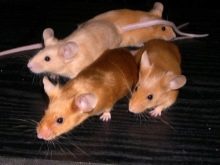
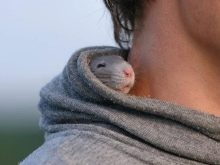
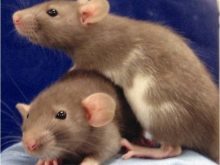
Rats are distinguished by such habits.
- Curiosity and the desire to try everything to the teeth and gnaw. Walking in the apartment, the pet examines all the things that interest him and secluded places.
- Grinding teeth - usually the animal expresses its good mood and joy in this way.
The domestic rodent is a curious, intelligent and cunning animal that is easy to train. By regularly exercising the rat, you can teach it easy tricks: bring different things, jump on any objects, climb a string and a hoop. Training should always be accompanied by treating your favorite treats, affectionate attitude and encouragement.
To accustom a rodent to a nickname, it is necessary to call affectionately during its feeding, often repeating its name.
The most difficult thing is to teach the animal to take food from the owner's hand. This will take quite a long time, and at first the pet, having taken the treat, will hide in the house.
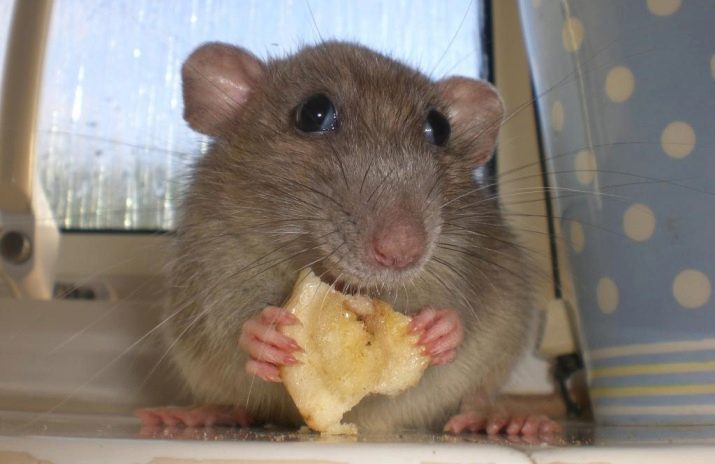
When training your pet, you need to apply such techniques.
- Using praise and treating a favorite treat that should be small in size, as this is only a reward for obedience.
- Before training, the rat should not be fed, it should feel some hunger. You can train it only after about 40 minutes after feeding.
The rat is able to learn such tricks: to climb on its hind legs, twirl around itself, jump from object to object. During training, the treat is held near the pet's nose and is led in the right direction: up, around, forward or backward.
The main rule of training is mastering first simple, and then more complex tricks.... Good contact with your pet only makes training easier.
Therefore, it is recommended to take him in your arms more often, stroke him, talk and praise.
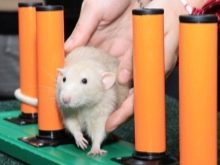
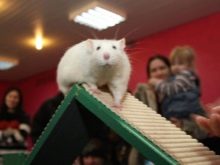

Reproduction
Breeding a domestic rat is a responsible process that requires the owner to take care of the female both during the gestation period and during her feeding. To get healthy babies it is necessary that the parents are also healthy and well-nourished.
For mating, they usually take a female of 5-8 months of age. The age of the male is not important. Before mating rodents, they need to be kept on food rich in vitamins for a week. This will ensure the birth of healthy, active and robust pups.
If the mating is successful, then the female becomes pregnant. The duration of pregnancy is approximately 21-24 days. A female carrying offspring is less active, picky about food. By week 3, the shape of her body changes: the belly becomes rounded and bulges out at the sides.
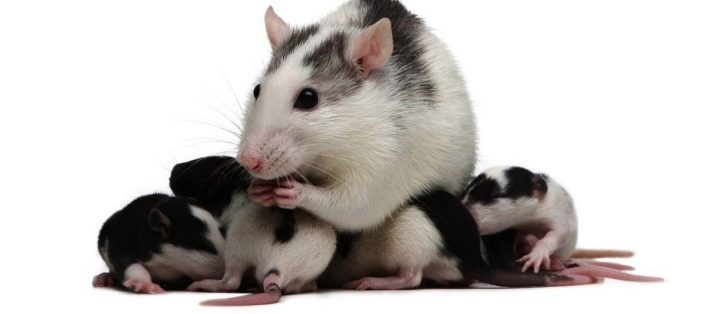
By the time the female is giving birth, the male must be isolated and transplanted into another dwelling. Remove all accessories from the cage, place soft paper (napkins, toilet paper) in her house so that the rat makes a nest. Rats are usually born at night. Childbirth lasts 2 to 3 hours. The domestic rat brings from 9 to 12 pups, which at the time of birth are blind and deaf, and also have no hair.
A lactating female should be given a high-calorie food that includes a high content of calcium and protein.This will ensure that the female is producing enough milk. Rats are caring and affectionate mothers: they often lick their pups and regularly feed them with milk.
The born cubs are distinguished by rapid growth and from the 4th day they already have hearing. The fur grows quickly enough in rat pups. By the 9th day, their first teeth grow - incisors. On the 12th day, they open their eyes, and after two weeks they are already capable of communicating with a person, they are very active and play fun.
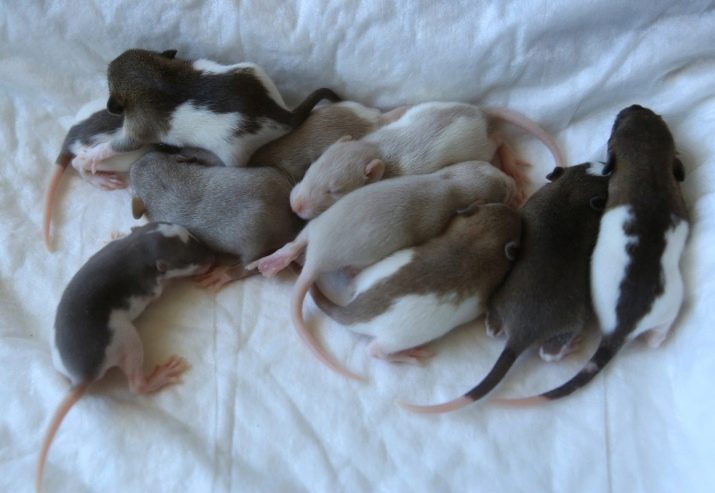
Interesting Facts
Rats, leading a nocturnal and hidden lifestyle, are very interesting animals that can surprise with their abilities. Here are some interesting facts about these rodents.
- Rats cannot distinguish colors and shades. Everything around him appears to them as spots of various sizes and brightness, which are in motion. Visual acuity is very low, but it is compensated by very fine hearing. Such hearing allows them to determine the direction and distance even to the slightest noise and rustle, as well as understand their cause. They also have a highly developed sense of smell.
- Another amazing ability of rats is that they have an inner vision that can anticipate disasters and catastrophes. This is confirmed by the well-known fact that rats always run from a sinking ship in advance. During the Battle of Stalingrad, rats left the city en masse before the German air raid.
- An amazing event that took place in France at the beginning of the 20th century confirms the ability of rats to foresee events. From one food market that was closing, all the rats living there, one day before closing, moved together to exactly the place where he was moving. How the rats found out about this remains a mystery, since the move of the market was announced only in the newspaper.
- There are mutant rats. In New Guinea, in the area of the Bosavi crater, American scientists have discovered rats reaching 80 cm in length and weighing about 1.5 kg. But by nature, despite their frightening size, they are completely harmless, non-aggressive and sociable.
- In terms of mental development, the rat is higher than the cats. Rats are able to communicate with each other, making high-frequency sounds that mean certain concepts and words, and they sound the same in different rodents. Scientists state that rat sounds are similar to human communication.
- Rats are remarkably clean and hygienic. They can wash themselves for several hours a day. Rodents have absolutely no fear of water and dive well.
- They also have a good memory and can remember the road the first time. Therefore, they are not able to get lost and determine the correct path in the labyrinths.
- The rat has a strong immune system and is not exposed to almost any disease. This is a consequence not only of their cleanliness, but also of innate good health. Scientists have found in them a gene that protects individuals from genital infections.
- Scientists' studies have shown the similarity between humans and rats: the structure of the human brain and the rat brain is very similar, and the blood is 80% the same in terms of its constituent elements.
- The physiological feature of the rat heart is that it makes from 300 to 500 beats per minute.
- Rats appeared on our planet 48 million years earlier than humans.
- A rat can swim many kilometers for three days without stopping, and can drown only if it cannot get out of the water.
- The gray rat can run at a speed of about 10 km / h, jumps up to 80 cm in height, and in a state of aggression - up to 2 meters.
- The rat can determine that the food is poisoned even if the proportion of the poison is minimal.
- The rat is the only mammalian animal that can laugh.
The temperament of tame rats is fundamentally different from the temperament of their wild relatives. They can be safely kept at home, tamed and receive love, trust and affection in return.
Those who decide to get this amazing animal need to know that rats cannot be kept together with birds, hamsters and mice, but they get along well with guinea pigs and decorative rabbits.
You will learn more about caring for domestic rats in the following video.








